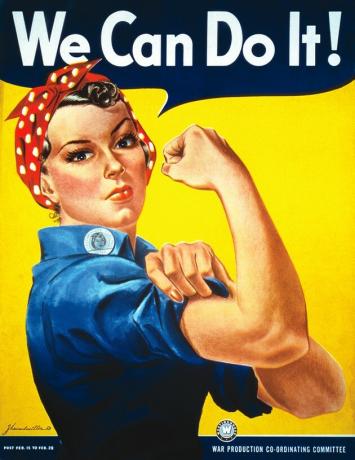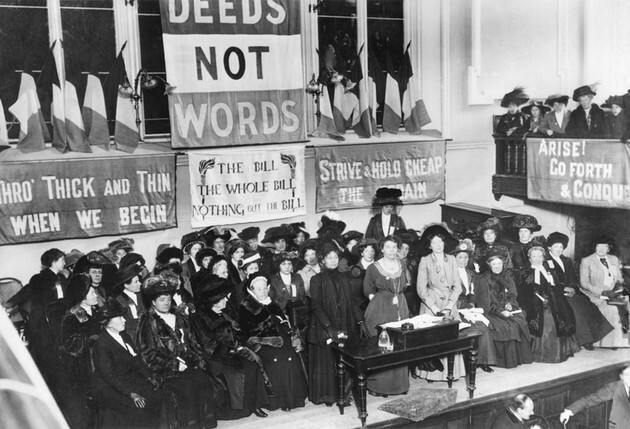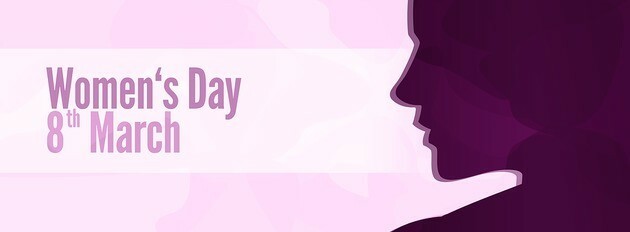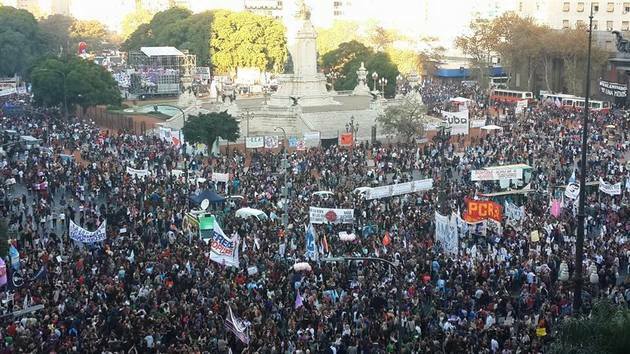The history of feminism summarized in 18 key moments (from its origin to the present)
Feminism is made up of various movements, each of which emphasizes a specific aspect because, even in the societies that have advanced the most in the equality, there are important differences in the recognition of rights that derive from conditions such as poverty, ethnic origin, religion or sexual orientation of women. women.
All this makes it necessary to understand what are those key moments in history that have shaped the identity and diversity of the feminist movement at the international level, and the reasons that make this movement still have much to make.

It was designed with the purpose of boosting the morale of women workers during World War II.
1. 1791: publication of the Declaration of the rights of women and citizens
The French writer Olympia de Gouges was aware that, after all, the proclamations of the Revolution French were only conceived for men and that women had been relegated to the realm of private.
Gouges published his controversy Declaration of the rights of women and citizens, in an obvious wink in front of the Declaration of the rights of man.
As a consequence, the Girondists ordered a trial against Gouges and sentenced her to the guillotine, which occurred in 1793. This moment highlighted the naturalization of discrimination and violence against women.
2. 1792: edition of the book Vindication of women's rights
In 1792, the writer Mary Wollstonecraft, one of the first to live independently as a writer, published the book Vindication of women's rights.
In it, Wollstonecraft reflects on the ethics and place of women in society, under the values that the Enlightenment had instilled in that generation, as the principle of individual freedom, reason, equality and fraternity.
3. 1848: Seneca Falls conference
The Seneca Falls conference in New York was the first convention in history for women's rights. It was organized by activists Lucretia Mott and Elizabeth Cady Stanton.
From this convention, a controversial document emerged that, inspired by the North American constitution, denounced the implicit and effective prohibition that women participate in the vote, elections and public office, as well as the express prohibition of affiliating with political organizations or attending meetings of this cut.
4. 1869: start of the suffrage movement

With the book Restraint of the woman, the writers Harriet Taylor and John Stuart Mill open the battlefield for the suffrage movement in Britain. In addition, the text promotes the transformation of some laws, such as the marriage law, proposes the access of the women to education and denounces the manipulation of female sexuality as an instrument of control over women.
That same year, Susan B. Anthony and Elizabeth Cady Stanton founded a New York voting rights movement for the woman called the National Woman Suffrage Association. Women).
Lucy Stone would do her own thing, and call her association the American Woman Suffrage Association.
5. 1893: female vote in New Zealand
New Zealand will be the first country to admit the female vote in the context of the contest, even though the islands Pitcairn, in Polynesia, had done it in 1838, but it had no impact because the islands were uninhabited a year following.
6. 1908: beginning of feminist labor movements
On March 8, 1908, a labor protest began in the United States. USA to demand days less than 12 hours, better salaries, the end of sexual harassment at work and the end of child labor. This will be the day that the unions of working women in EE. USA take as a reference to celebrate women's day.
7. 1947: equal pay for men and women in Sweden
Equal pay is not yet a universal reality. However, since 1947 Sweden has stood out as the first country to declare the right to the same salary for the same work.
8. 1948: Declaration of Human Rights
In 1948, the General Assembly of the United Nations Organization approved the Universal Declaration of Human Rights. In this, the mandate of recognition of gender equality before the laws in all its areas is made explicit. Likewise, the principle of equal rights is recognized without distinction of ethnicity, belief system, age, social class, etc.
See also: Feminism: know its most representative characteristics, works and authors.
9. 1949: publication of the book The second sex
In this year, Simone de Beauvoir's book called The second sex, a key piece in the reflection on the place of women in society and their rights.
You may also like: Simone de Beauvoir: 7 keys to understanding who she was and her contributions to feminism
10. 1968: debate on women's reproductive rights
This event has an important weight in the feminist debate, since 1968 was the first moment in which awareness of women's rights over reproduction was raised.
By then, the pill had been invented, which was a revolutionary change. The UN agenda included the discussion on the right to control reproduction, sexual education, sexual health and legal abortion.
11. 1973: first precedent for the legalization of abortion
Although this issue continues to generate much controversy, voluntary and legal abortion has been a point on the feminist agenda, with the purpose of preventing the deaths of women due to illegal abortions.
In 1973, a US court. USA approved the sentence known as "Roe against Wade", which recognizes the right of women to voluntary interruption of pregnancy, without implying a prison sentence. This sentence has been fundamental in the discussion on the subject and since it multiple debates have been generated.
12. 1977: officialization of International Women's Day

Until now, Women's Day has strictly referred to working women. In addition, it not only alluded to the demonstrations that paralyzed the industry in 1908, but also paid tribute to the women who were burned to death when their bosses decided to block the exits to prevent them from leaving their jobs in the factory.
The date became a fundamental reference for socialist feminism, but not all countries followed this calendar. In order to join international efforts to make visible the outstanding achievements and rights in the fight for an egalitarian society, the UN decides to officially declare the date in 1977.
13. 1992: start of the third wave of feminism
In 1992, feminist writer Rebeca Walker published a book called Becoming the Third Wave or Start of the third wave, in Spanish. In this text, she introduces a series of themes that become important in the theorizations and actions of feminism. contemporary, such as the right to sexual diversity, ecofeminism, the inequalities of feminism according to countries and societies, etc.
Since then, some problems have been added to the feminist to-do list, such as the problem of mentality colonized, ethnic origin as an aggravating factor of the condition of subalternity, the relationship of feminism with the community, etc.
14. 1999: International day against sexual exploitation and human trafficking
This day not only refers to women, but is of paramount importance in the context of the feminist struggle. The severity of this scourge is such that human trafficking, for sexual purposes or not, has become as profitable an industry as drugs and arms trafficking.
Statistics indicate that 80% of the victims are women and girls. In the case of the female population, 95% of them are destined for sexual exploitation.
It was the World Conference of the Coalition Against Human Trafficking together with the Women's Conference that took place in Dhaka, Bangladesh, which established on September 23 to raise awareness about the problem of sexual exploitation and trafficking in people.
15. 2009: judgment of Campo Algodonero
The year 2009 revealed one of the most terrible realities for women that has not been overcome: the gender violence. In this sense, the case of the femicides in Ciudad Juárez, Mexico, in which the negligence of the authorities has been an aggravating factor, was famous.
The judgment of Campo Algodonero was promulgated by the Inter-American Court of Human Rights, in which the State was obliged to apologize to the families of the victims of Ciudad Juárez and to facilitate the investigation processes on the crimes.
16. 2012: World Day of Zero Tolerance against Female Genital Mutilation
At its 2012 assembly, the UN approved the annual commemoration of the World Day of Zero Tolerance against Female Genital Mutilation every February 6.
This date is intended to raise awareness regarding the fact that fundamental human rights cannot be subordinated to cultural traditions under any circumstances.
The UN thus recognizes that female genital mutilation is an act of violence against women and calls for its ban throughout the world.
17. 2015: Argentine march "Not one less"

The fight for feminist rights has been revitalized, because despite all these achievements, a fundamental right has not been guaranteed: the right to life and to dignified treatment free from violence.
The number of femicides it seems to be increasing, the proportion of rapes has not decreased, the disappearance of women continues without a response from the authorities. Violence against women is a reality that overshadows the achievements so far.
For this reason, in 2015 the first march of the Argentine movement took place. Not one less, which denounces femicide. This march mobilized more than 80 cities in that country and became a model of inspiration for many women in the world. The march has been replicated in countries such as Uruguay, Mexico, Ecuador, Bolivia and Venezuela, and has also become an annual event.
18. 2017: great international march for women's rights
In the USA USA One of the most important marches of feminism took place, mobilized by the electoral triumph of Donald Trump, whose conservatism is more than known. At the international level, other similar demonstrations were held to raise awareness about the inequalities that continue to oppress women.
More than two and a half million women took to the streets in 2017 around the world to assert their rights and human dignity. Many more continue to fight by all the means they know, public and private, to make equality and peace a reality.

